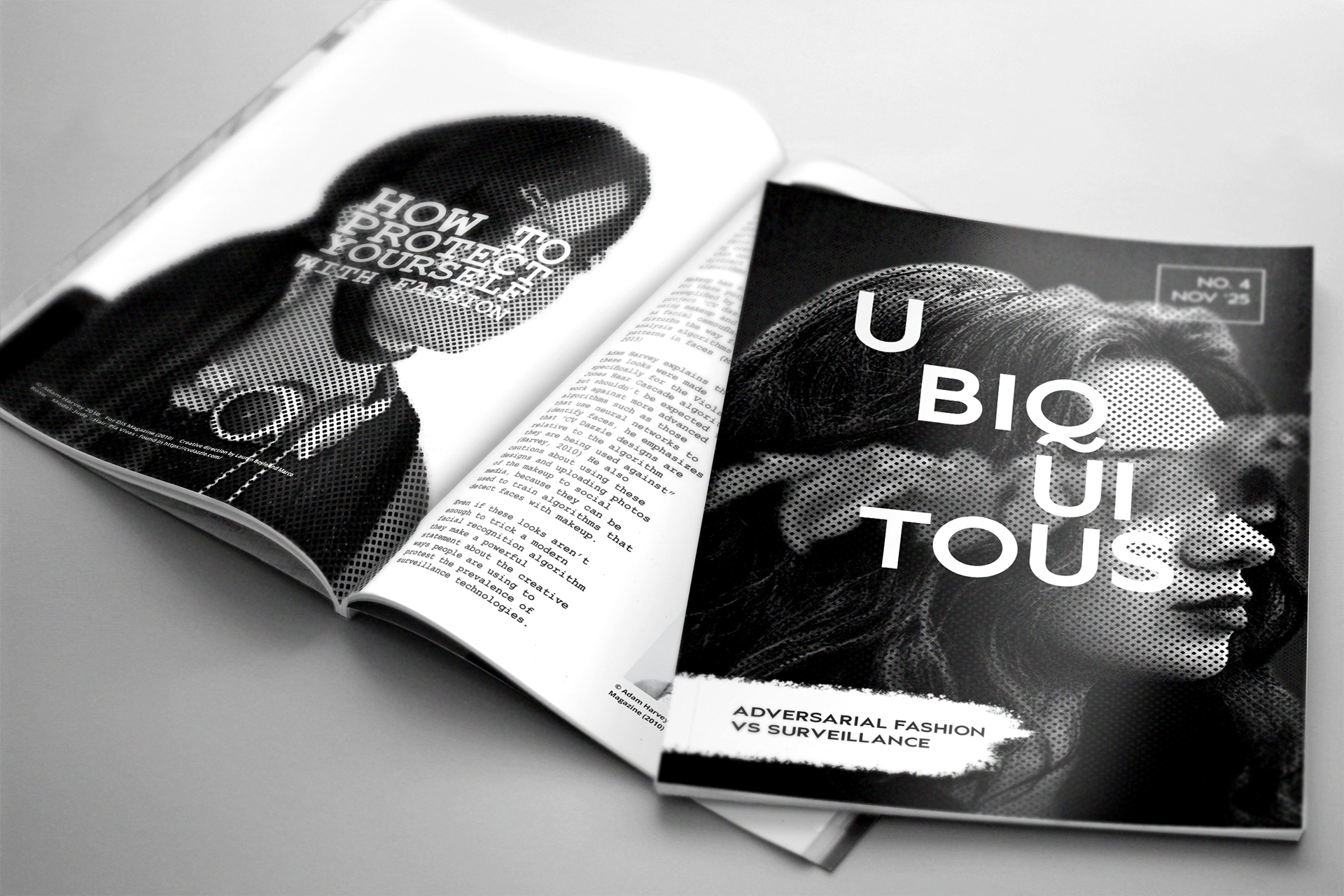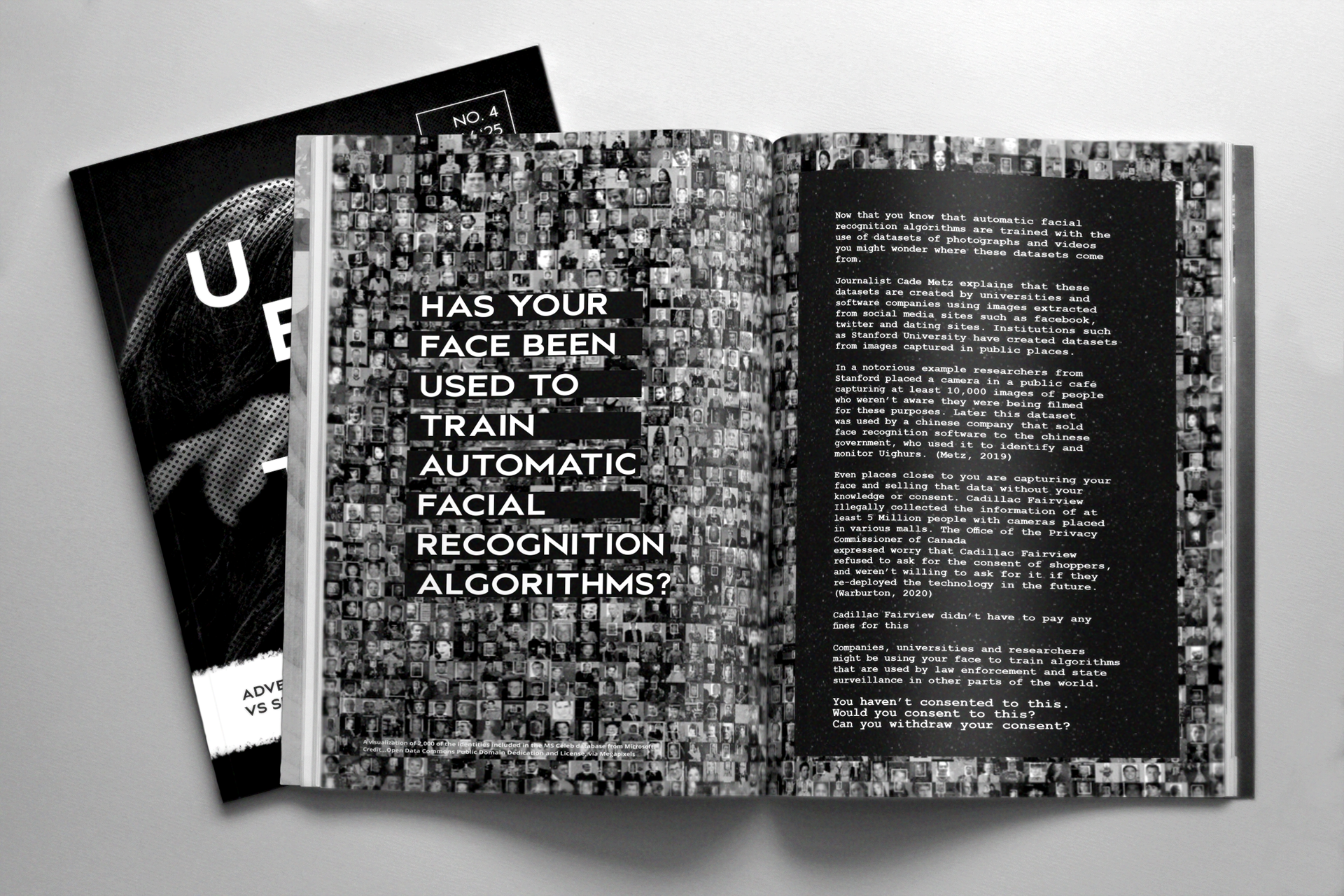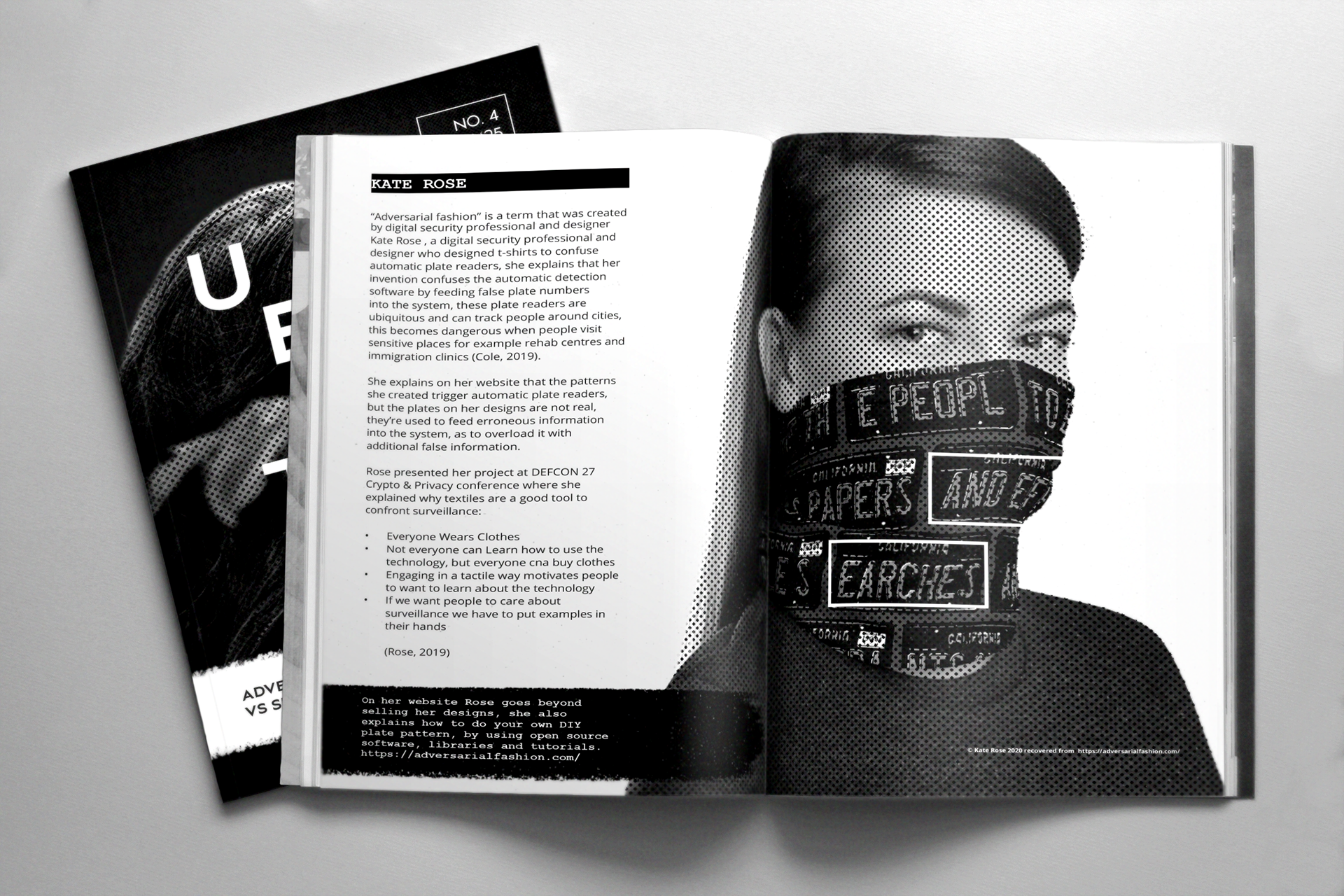Ubiquitous Zine



ABSTRACT
For this project I designed a zine to explain to readers the importance of privacy and how to use fashion elements to combat automatic facial surveillance. Surveillance has become ubiquitous in this future and citizens search for ways to resist through the use of clothing, makeup and DIY technologies that help them navigate the city without being tracked by surveillance cameras and keep their privacy. “Adversarial Fashion” has been used in many ways to do this: From confusing plate reading cameras, to disrupting how an algorithm interprets facial features. I decided a zine would be a good medium to confront surveillance since it is a handmade collaborative medium which is also cheap to make and impossible to track, at the same time it’s a political medium which has been used to protest, connect and share solidarity.
Automated facial recognition is a technology that is used mostly as a control and policing tool to identify faces in crowds in order to find particular people. This technology works by training artificial intelligence with datasets of faces that are classified with demographic attributes such as race, ethnicity, gender and age. To have accurate algorithms lots of data is needed to teach AI to differentiate between different types of faces, here is where datasets come into play, these datasets are created by extracting information from people’s faces, these images come from social media or from cameras placed on public spaces where most people haven’t agreed to having their faces recorded.
Automated facial recognition has grave consequences for democracy, Cade Metz describes a case in which a dataset created by Stanford researchers was shared over the internet and was used by a chinese company who provided facial recognition technology to the chinese government to monitor Uighurs (Metz, 2019). Joy Bwolamwini has researched the biases hidden in these algorithms especially those concerning race, she explains that “Among the most concerning uses of facial analysis technology involve the bolstering of mass surveillance, the weaponization of AI, and harmful discrimination in law enforcement contexts.” (Bwolamwini, 2019) In the world I described on assignment 2 people try to use masks, fashion and makeup to be able to move through the city without feeding into this type of surveillance and to be able to live their public lives without fear of being recognized or tracked by this type of software, specially people who are marginalized.
Zines became popular during the 70’s in punk culture and were popular until the 90’s with the publication of many Grrrl Zines, which were created by young punk women. Radway defines zines as “handmade pamphlets self-published through small-scale reproduction and circulation, were a ubiquitous presence within the punk scene” (Radway, 2016, 7) , Zines allowed people in the punk scene to write not only about music but also about political issues that were important to them, Radway explains that “ ...were among the first to explore the angry views of girls interested in calling out the multiple ways they were dismissed, scorned, violated, and controlled” (Radway, 2016, 7).
Zines are an ideal medium for this project because of their material qualities: They are produced and reproduced in very cheap ways using only paper and photocopying machines. In the case of the world I have described there is great concern about surveillance, zines overcome this by being circulated only in print which means they can’t be tracked to a single source and is impossible to know who has read or shared them and can be eliminated without a trace because they don’t generate any extra metadata that can be exploited. Another characteristic that makes zines important in this world is the political implication of zines as mediums of free expression, solidarity and protest. Zines can be used to educate peers about important issues that affect a community, in the case of the world described teaching people how to protect themselves is a statement against ubiquitous surveillance.
“Adversarial fashion” is a term coined by digital security professional and designer Kate Rose (Cole, 2019) who designed t-shirts to confuse automatic plate readers, she explains that her invention confuses the automatic detection software by feeding false plate numbers into the system, these plate readers are ubiquitous and can track people around cities, this becomes dangerous when people visit sensitive places for example rehab centres and immigration clinics. Other people have used makeup to obscure their face or confuse facial recognition algorithms, this is the case of Adam Harvey a designer and technologist who developed “CV dazzle”, a type of facial camouflage that disturbs the way facial analysis algorithms find patterns in faces, thus making recognition impossible (Meyer, 2015).
Torin Monahan critiques these kinds of initiatives, he explains that they are an aestheticization of resistance which fails to challenge the violence and discrimination from surveillance society. He also explains how some of these artistic initiatives are more based on the individual and not in opposing surveillance as a group. (Monahan, 2015). Monahan concludes that these artistic interventions would be more powerful if they could be used to look back at the establishment that is doing the surveillance and uncovering that which the establishments want to keep hidden.
In my initial prototype I should have considered Monahan’s points and his arguments have informed my decision to write a zine. Through this zine I want to invite people to learn about artistic projects that confront surveillance as well as give readers an introduction about automated facial recognition and invite them to question how prevalent surveillance is in their lives and what it means to them and their communities, especially for people who live in Toronto, which is heavily surveilled now and in the imagined future. Instead on focusing on my “face-off” project from assignment #2 I want to reflect on the two projects I’ve described in this reflection, this is because these projects go beyond the design of a product, the artists behind them have shared a vision about the right to privacy and have shared tools for people to combat surveillance in their own lives.
In my initial prototype I should have considered Monahan’s points and his arguments have informed my decision to write a zine. Through this zine I want to invite people to learn about artistic projects that confront surveillance as well as give readers an introduction about automated facial recognition and invite them to question how prevalent surveillance is in their lives and what it means to them and their communities, especially for people who live in Toronto, which is heavily surveilled now and in the imagined future. Instead on focusing on my “face-off” project from assignment #2 I want to reflect on the two projects I’ve described in this reflection, this is because these projects go beyond the design of a product, the artists behind them have shared a vision about the right to privacy and have shared tools for people to combat surveillance in their own lives.
References
Buolamwini, J. (2019, April 24). Response: Racial and Gender bias in Amazon Rekognition - Commercial AI System for Analyzing Faces. Retrieved November 11, 2020, from https://medium.com/@Joy.Buolamwini/response-racial-and-gender-bias-in-amazon-rekognition-commercial-ai-system-for-analyzing-faces-a289222eeced
Metz, C. (2019, July 13). Facial Recognition Tech Is Growing Stronger, Thanks to Your Face. Retrieved November 13, 2020, from https://www.nytimes.com/2019/07/13/technology/databases-faces-facial-recognition-technology.html
Cole, S. (2019, August 15). This Hacker Made Clothes That Can Confuse Automatic License Plate Readers. Retrieved November 12, 2020, from https://www.vice.com/en/article/qvgpvv/adversarial-fashion-clothes-that-confuse-automatic-license-plate-readers
Cole, S. (2019, August 15). This Hacker Made Clothes That Can Confuse Automatic License Plate Readers. Retrieved November 12, 2020, from https://www.vice.com/en/article/qvgpvv/adversarial-fashion-clothes-that-confuse-automatic-license-plate-readers
Monahan, T. (2015). The Right to Hide? Anti-Surveillance Camouflage and the Aestheticization of Resistance. Communication and Critical/Cultural Studies, 12(2), 159–178. https://doi.org/10.1080/14791420.2015.1006646
Meyer, S. (2015, August 20). How I Hid From Facial Recognition Surveillance Systems. Retrieved November 30, 2020, from https://www.theatlantic.com/technology/archive/2014/07/makeup/374929/
Radway, J. (2016). Girl Zine Networks, Underground Itineraries, and Riot Grrrl History: Making Sense of the Struggle for New Social Forms in the 1990s and Beyond. Journal of American Studies, 50(1), 1–31. https://doi.org/10.1017/S0021875815002625
